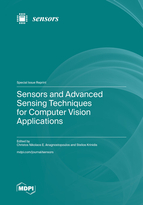Sensors and Advanced Sensing Techniques for Computer Vision Applications
A special issue of Sensors (ISSN 1424-8220). This special issue belongs to the section "Physical Sensors".
Deadline for manuscript submissions: closed (30 September 2024) | Viewed by 49341
Special Issue Editors
Interests: 3D modeling; 3D visualization; digital culture; face recognition; mixed reality; multimedia
Special Issues, Collections and Topics in MDPI journals
Interests: signal and image processing; computer vision; artificial intelligence; information analysis; data mining; big data; data and visual analytics
Special Issues, Collections and Topics in MDPI journals
Special Issue Information
Dear Colleagues,
The Special Issue on “Sensors and Advanced Sensing Techniques for Computer Vision Applications” addresses all topics related to the challenging problems of computer vision and pattern recognition in conjunction with the emerging field of deep learning. Technologies related to computational intelligence, including deep learning, neural networks and soft computing will be considered from both the theoretical and technological points of view, with advanced 2D/3D computer vision and visualization infrastructures.
Classical computer vision systems use visible-light 2D cameras combining a 3D scene using photogrammetry, while 3D vision systems use more sophisticated acquisition sensors, such as structured-light 3D scanners, thermographic cameras, hyperspectral imagers and lidar scanners. As a consequence, the classical tasks of computer vision are now handled in 3D space (point clouds, meshes, 3D objects), and artificial intelligence finds a new area to thrive in using deep learning for the comparative analysis of huge amounts of data.
The topics of this Special Issue on “Sensors and Advanced Sensing Techniques for Computer Vision Applications” include (but are not limited to) the following aspects of computer vision and pattern recognition:
- Deep learning for 2D/3D object recognition and classification
- Reinforcement learning and robotic agents
- Data augmentation in computer vision
- Digital twins
- Multidisciplinary applications of deep learning, pattern recognition and computer vision
Multidisciplinary applications can be reported in numerous scientific fields addressing everyday life problems, including engineering, architecture, energy, robotics, medicine, cultural heritage, mixed reality and creative media/entertainment.
Prof. Dr. Christos Nikolaos E. Anagnostopoulos
Dr. Stelios Krinidis
Guest Editors
Manuscript Submission Information
Manuscripts should be submitted online at www.mdpi.com by registering and logging in to this website. Once you are registered, click here to go to the submission form. Manuscripts can be submitted until the deadline. All submissions that pass pre-check are peer-reviewed. Accepted papers will be published continuously in the journal (as soon as accepted) and will be listed together on the special issue website. Research articles, review articles as well as short communications are invited. For planned papers, a title and short abstract (about 100 words) can be sent to the Editorial Office for announcement on this website.
Submitted manuscripts should not have been published previously, nor be under consideration for publication elsewhere (except conference proceedings papers). All manuscripts are thoroughly refereed through a single-blind peer-review process. A guide for authors and other relevant information for submission of manuscripts is available on the Instructions for Authors page. Sensors is an international peer-reviewed open access semimonthly journal published by MDPI.
Please visit the Instructions for Authors page before submitting a manuscript. The Article Processing Charge (APC) for publication in this open access journal is 2600 CHF (Swiss Francs). Submitted papers should be well formatted and use good English. Authors may use MDPI's English editing service prior to publication or during author revisions.
Benefits of Publishing in a Special Issue
- Ease of navigation: Grouping papers by topic helps scholars navigate broad scope journals more efficiently.
- Greater discoverability: Special Issues support the reach and impact of scientific research. Articles in Special Issues are more discoverable and cited more frequently.
- Expansion of research network: Special Issues facilitate connections among authors, fostering scientific collaborations.
- External promotion: Articles in Special Issues are often promoted through the journal's social media, increasing their visibility.
- Reprint: MDPI Books provides the opportunity to republish successful Special Issues in book format, both online and in print.
Further information on MDPI's Special Issue policies can be found here.








